Crafting with kids opens magical doors to their imagination while building essential skills. Popular projects include nature collages, recycled masterpieces, DIY storybooks, and paper plate puppets that spark creativity with minimal supplies. Upcycled container gardens teach environmental awareness, while rock painting and clay sculpting allow tactile exploration. Seasonal decorations connect children to nature’s rhythms, and personalized room signs foster identity. These hands-on activities nurture young minds and creative spirits beyond simple art projects.
Key Takeaways
- Creating nature collages with found materials develops creativity and fine motor skills while connecting children with the outdoors.
- Transforming recycled materials into art projects teaches environmental responsibility and problem-solving through resourceful crafting.
- DIY storybooks and puppets encourage emotional expression, storytelling skills, and help children process complex feelings.
- Rock painting offers an accessible canvas for creative expression, resulting in meaningful gifts or decorative pieces.
- Cardboard box worlds and origami projects spark imagination through construction play and transform simple materials into interactive environments.
Nature Collages: Connect Children With the Outdoors
Many creative opportunities await when children venture outdoors to gather materials for nature collages. Kids can collect fallen leaves, driftwood, and seaweed to encourage creativity and imagination while they transform these treasures into stunning artwork.
The best part? This activity not only builds artistic skills but also boosts mood and reduces stress—talk about a win-win situation!
Nature art activities offer dual benefits: enhancing creativity while naturally improving mood and easing tension.
As children arrange their findings with PVA glue and mixed media, they develop fine motor skills and coordination. The process invites them to investigate their surroundings, sparking curiosity about the natural world.
Through these artistic adventures, kids express thoughts and emotions that might otherwise remain bottled up. Nature collages create the perfect bridge between artistic expression and environmental appreciation, making outdoor exploration twice as rewarding!
DIY Storybooks: Empowering Self-Expression
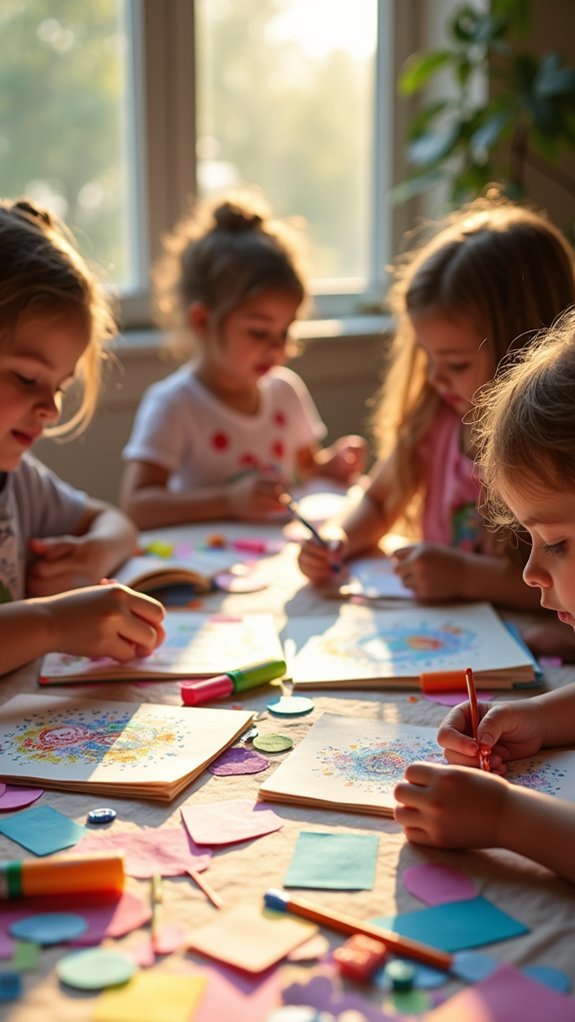
While nature collages capture the physical environment, DIY storybooks reveal the scenery of a child’s imagination. Creating these personal books helps children express their feelings and thoughts through characters that mirror their own experiences. Research shows that crafting stories actually improves kids’ emotional regulation!
When children illustrate their narratives, they’re developing critical thinking about how stories work and building confidence as they watch their ideas become real, shareable art.
| DIY Storybook Benefits | How It Helps |
|---|---|
| Emotional expression | Safe outlet for feelings |
| Creativity boost | Develops artistic skills |
| Relationship building | Creates meaningful gifts |
| Storytelling skills | Improves communication |
| Self-confidence | Celebrates personal ideas |
These handmade treasures often become cherished gifts for family members, strengthening bonds while giving kids pride in their creative accomplishments.
Recycled Masterpieces: Turning Trash Into Treasure
Buried beneath piles of empty cereal boxes and plastic bottles lies a world of artistic potential that children can access with imagination and creativity.
Transforming everyday “trash” into treasured artwork teaches kids environmental responsibility while boosting problem-solving skills. These projects create a perfect opportunity for children to see value in discarded items, developing resourcefulness that will serve them throughout life.
Try these simple recycled art projects that spark creativity:
- Bottle cap mosaics – collect colorful caps to create vibrant designs on cardboard
- Cardboard tube creatures – transform toilet paper rolls into animals, robots, or characters
- Plastic bottle planters – cut, decorate, and fill with soil to grow small herbs or flowers
The joy on a child’s face when they’ve created something beautiful from “nothing” is absolutely priceless!
Paper Plate Puppets: Characters Come Alive
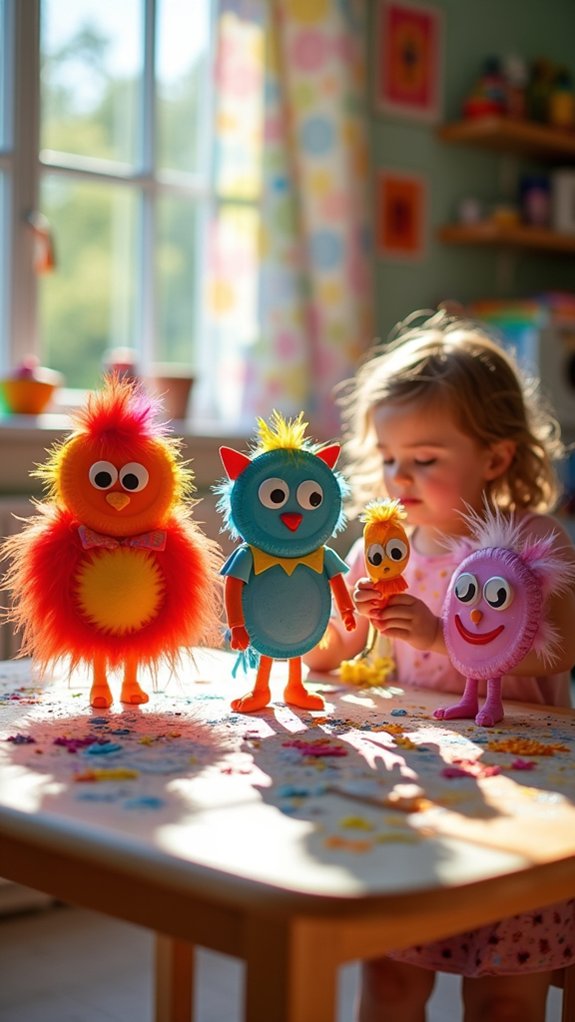
Paper plate puppets transform ordinary household items into gateways for imaginative adventures that captivate young minds. With just a paper plate, some markers, and a dash of creativity, children can breathe life into characters that dance, speak, and perform at their fingertips!
This accessible craft requires minimal setup but delivers maximum fun, making it perfect for rainy afternoons or playdate activities. As kids design their puppet personalities, they’re actually building essential storytelling skills and emotional intelligence.
The true magic happens when children gather to put on impromptu shows, working together to create narratives that spark roaring laughter or dramatic gasps. Research shows that this type of imaginative play in children supports their ability to understand and process complex emotions, turning simple paper creations into powerful tools for growth and expression.
Origami Adventures: Folding Paper Into Magic
Simple origami folds like the classic paper boat or jumping frog may seem basic, but they open the door to an entire world of paper-folding magic for kids.
Once children master these beginner techniques, they can join mini origami competitions where creating the most beautiful crane or fastest paper airplane becomes an exciting challenge.
These friendly contests not only showcase creativity but also build confidence as young folders transform ordinary paper into extraordinary art through careful creases and folds.
Simple Starting Folds
Diving into origami opens up a magical world where flat sheets transform into three-dimensional wonders. Children can start with super easy to make designs that build their confidence while secretly developing fine motor skills.
The patient folding of paper creates a calm, focused mindset—perfect for restless young minds needing a moment of creative zen.
Here are three awesome starter folds to try:
- Paper boats that actually float in water
- Jumping frogs that hop when you press their backs
- Simple hearts that make sweet gifts for family and friends
These quick projects usually take less than five minutes to complete, making them perfect for short attention spans.
As kids master these basic folds, they’re actually exploring geometry concepts—without realizing they’re learning while having a blast!
Mini Origami Competitions
While mastering basic folds provides a foundation, mini origami competitions take paper-folding adventures to thrilling new heights! These fun contests enhance children’s fine motor skills and concentration as they carefully create precise folds.
Kids love the friendly rivalry that sparks creativity and encourages them to design unique paper masterpieces. Themed competitions, like “Awesome Animals” or “Holiday Decorations,” inspire young artists to explore diverse folding patterns while showcasing their personalities.
Beyond the artistic benefits, these paper-folding showdowns foster valuable social skills as participants share tips and build friendships. Research even shows that origami activities reduce stress and promote mindfulness—a hidden bonus while kids are enjoying themselves!
Painted Rock Creations: Portable Art Projects
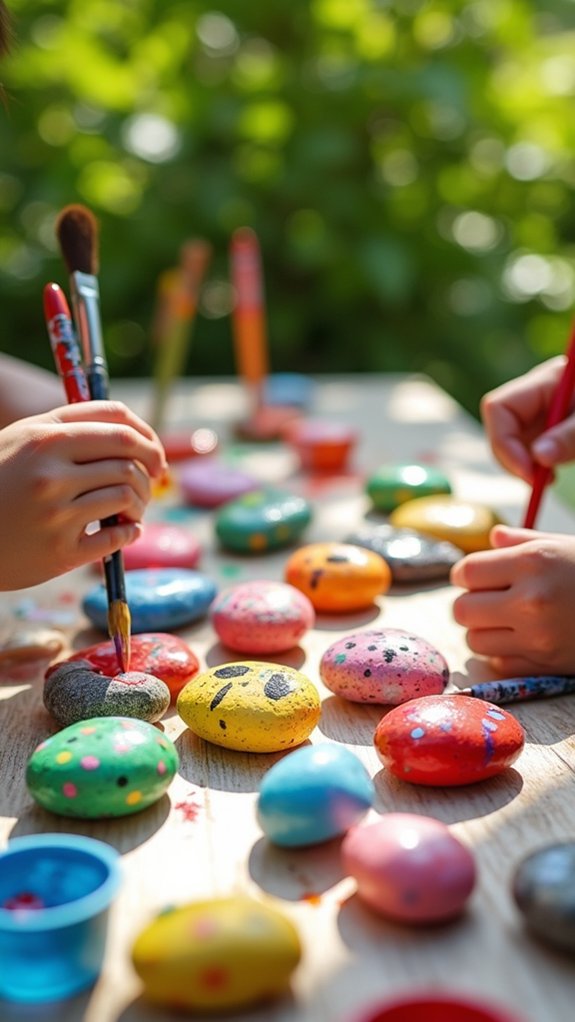
Painted rocks offer kids a world of creative possibilities, from designing adorable character rocks with funny faces to crafting nature-inspired stone masterpieces featuring flowers, animals, and sceneries.
These portable art projects make thoughtful, one-of-a-kind gifts that friends and family will treasure, especially when personalized with special messages or decorated to match the recipient’s interests.
Children can hide their finished rock creations around the neighborhood as part of community “rock hunting” games, spreading joy and surprise to anyone lucky enough to discover these miniature works of art.
Character Rocks Delight
When ordinary rocks transform into whimsical characters, kids discover a whole new world of creative possibilities. These pocket-sized canvases ignite a child’s creativity while providing hours of artistic enjoyment.
Using simple materials like acrylic paints and brushes, youngsters can breathe life into stone surfaces, creating portable masterpieces that reflect their unique personalities.
To create charming character rocks:
- Start with a smooth, clean rock as your canvas.
- Sketch your design lightly in pencil before adding vibrant paint layers.
- Seal your finished creation with a clear coat to protect your artwork.
Beyond the artistic benefits, these painted companions serve as stress-reducers and imagination-boosters. Kids often invent elaborate stories featuring their rock characters, enhancing their storytelling abilities while they play.
The finished rocks make heartfelt gifts or delightful decorations for any space!
Nature-Inspired Stone Designs
Beyond character designs, the natural world offers endless inspiration for creative rock artistry. Kids can press actual leaves onto painted surfaces or recreate flowing water patterns using swirls of blue and white.
These nature-inspired craft activities not only spark imagination but also help reduce stress—scientists have actually proven it!
Finding perfect stones becomes an adventure itself, with smooth river rocks offering the best canvas. Children can use cotton buds to add delicate details like flower petals or dragonfly wings.
Once finished, these portable masterpieces transform ordinary spaces into magical ones!
The best part? These decorated stones can become garden markers, thoughtful gifts, or even confidence boosters when painted with encouraging words.
Place them around the house as daily reminders that creativity, like nature itself, can appear in the smallest packages.
Personalized Rock Gifts
Every personalized rock gift tells a unique story through colors, shapes, and designs that reflect the creator’s imagination. Rock painting transforms ordinary stones into meaningful treasures that kids can share with friends and family.
These portable art projects not only spark creativity but also promote emotional well-being through artistic expression.
When creating personalized rock gifts, young artists might consider:
- Painting special messages or inspirational quotes for teachers
- Designing colorful pet portraits for animal-loving friends
- Creating miniature scenes that remind someone of a favorite place
The beauty of these handcrafted presents lies in their uniqueness—no two painted rocks are exactly alike!
Children feel a sense of pride when offering something they’ve made themselves, turning simple stones into heartfelt tokens that recipients will cherish for years to come.
Handmade Greeting Cards: Spreading Joy and Gratitude
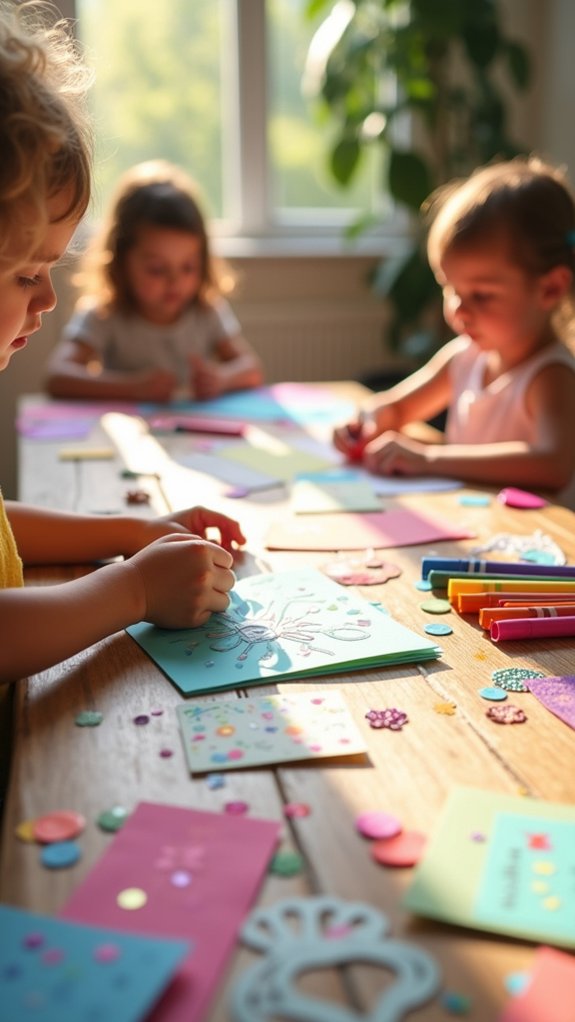
Handmade greeting cards offer children a beautiful way to express their feelings while developing important skills. When kids craft these personalized messages, they’re not just creating paper art—they’re building emotional connections with teachers, friends, and family members.
The simple act of designing and writing cards helps children practice fine motor skills while releasing their artistic creativity.
Research has shown that expressing gratitude through handmade greeting cards can boost psychological well-being, giving kids an emotional health advantage. As children consider what messages to include, they develop empathy by thinking about what might make the recipient smile.
Creating handmade cards teaches children gratitude and empathy—essential skills that foster emotional well-being as they connect with others.
This thoughtful process encourages them to tell stories through both images and words, transforming a simple craft activity into a meaningful exercise in compassion and communication.
Sock Puppets: Bringing Stories to Life
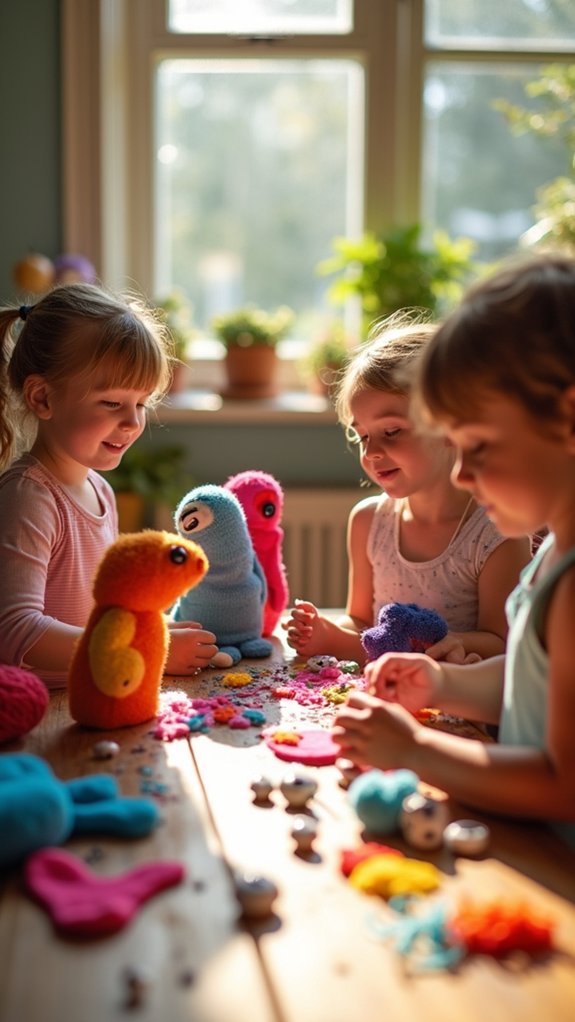
Sock puppets transform ordinary socks into extraordinary characters that bring children’s wildest stories to life.
Kids can design creatures with unique personalities using buttons, yarn, and fabric scraps, then watch as their creations become the stars of imaginative puppet shows.
These handmade performers not only entertain but also build confidence and communication skills, especially when kids organize themed shows like fairy tale adaptations or space adventures.
Character Creation Options
Many creative adventures begin with a simple, forgotten sock transformed into a chatty character with personality and charm.
Children’s imagination soars as they decide if their puppet will be a silly monster, a wise wizard, or perhaps a friendly animal companion for storytelling sessions.
When designing sock puppets, kids have endless character creation options:
- Base characters – Use colorful socks for happy characters, dark ones for mysterious figures, or striped patterns for playful personalities.
- Facial features – Add button eyes, yarn hair, felt tongues, or fabric ears to create unique expressions.
- Personality props – Attach tiny hats, bowties, or jewelry to give puppets distinct personalities.
This creative process helps children visualize their imaginary friends, making emotional expression and storytelling more concrete and engaging through hands-on crafting.
Puppetry Play Benefits
Once children bring their sock puppets to life, a world of developmental advantages unfolds before them. The puppetry play benefits extend far beyond simple entertainment!
While performing imaginative scenarios, kids develop storytelling abilities and boost their creativity in ways that ordinary toys can’t match. Sock puppets create a safe space for children to express emotions and explore different perspectives, building emotional intelligence with every character they animate.
The hands-on crafting process strengthens their fine motor skills as they attach buttons, yarn, and fabric pieces to their puppets. When friends gather for puppet shows, they practice essential communication and teamwork skills.
It’s amazing how a simple sock can transform into a powerful tool for learning, connecting, and growing—all while kids think they’re just having fun!
Themed Show Ideas
Now that children have their puppet pals ready for action, it’s time to let their creativity truly shine through themed performances! Sock puppet shows provide an easy platform for kids to express emotions and collaborate with friends, turning ordinary afternoons into extraordinary adventures.
Consider these engaging themes that will captivate young imaginations:
- Fairy Tale Reimagined – Kids can put their own twist on classics like Cinderella or The Three Little Pigs, developing narrative skills while keeping traditions alive.
- Space Explorers – Sock astronauts discover new planets and overcome cosmic challenges, encouraging problem-solving through storytelling.
- Eco-Heroes – Puppets tackle environmental missions, teaching children about conservation while they repurpose those lonely odd socks into characters saving the day!
Beaded Jewelry Making: Wearable Art Designs
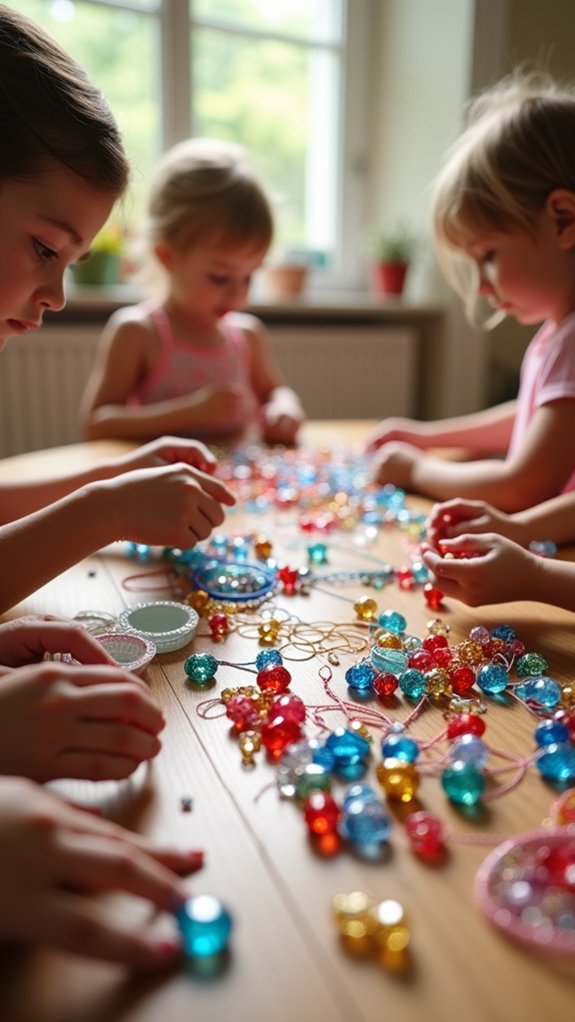
Transform ordinary beads into extraordinary wearable art with this engaging craft that sparks creativity in young minds. Beaded jewelry making isn’t just fun—it’s a powerful way for kids to express themselves while developing essential fine motor skills as they thread colorful beads onto strings or wires.
Children can use new beads or repurpose old ones, learning eco-friendly practices while creating unique accessories. The pride that comes from wearing their own creations or gifting them to others provides a significant confidence boost!
Plus, when friends gather to make bracelets, necklaces, or earrings together, they’re building social skills alongside their jewelry collections. This craft encourages patience and persistence, as intricate designs take time to complete—but the results are always worth the effort!
Clay Sculptures: Molding Imagination Into Reality
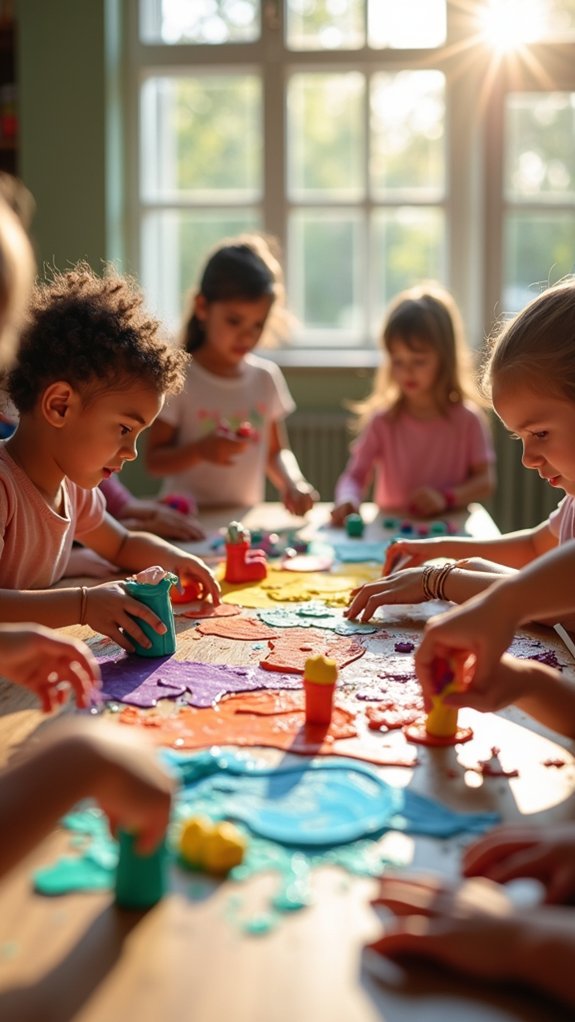
While beads bring beauty to wearable creations, clay offers a different kind of magic entirely. Clay sculptures transform children’s wild ideas into touchable art, allowing them to squish, roll, and shape their imagination into reality. The feeling of cool clay between fingers isn’t just fun—it’s actually building fine motor skills and hand-eye coordination!
Children benefit from clay sculpting in three amazing ways:
- It reduces stress and anxiety, helping kids express emotions they can’t always put into words.
- It encourages storytelling as characters and objects take shape under creative hands.
- It offers double the artistic expression when sculptures can be painted after drying.
This hands-on craft lets kids literally mold their dreams, turning abstract thoughts into something they can proudly display on the family shelf!
Cardboard Box Worlds: Building Miniature Scenes
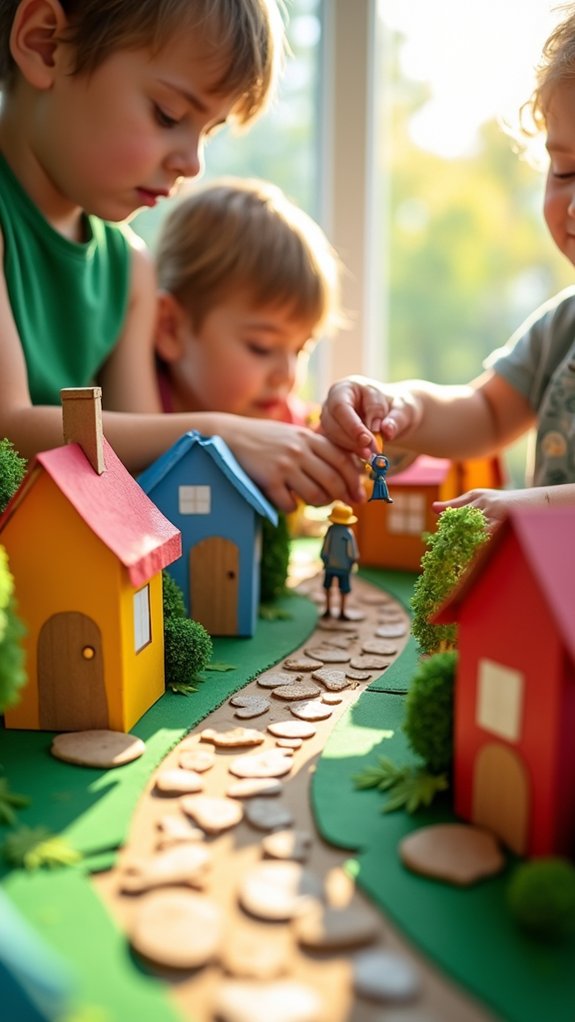
Cardboard box worlds offer kids the chance to craft enchanting miniature ecosystems where imagination blooms like wildflowers in spring.
These tiny environments—from fairy gardens to bustling cityscapes—become interactive playgrounds where action figures, toy cars, and handmade characters can set out on countless adventures.
With just a few recycled boxes, some craft supplies, and a spark of creativity, children can transform ordinary cardboard into extraordinary domains that reflect their unique interests and stories.
Enchanting Miniature Ecosystems
A magical miniature universe exists within the humble confines of a cardboard box, waiting for creative young hands to bring it to life. When little ones transform recycled materials into lush forests, bustling cityscapes, or mysterious underwater domains, they’re not just crafting—they’re storytelling!
These cardboard ecosystems become stages for imagination while secretly developing fine motor skills through cutting, gluing, and arranging tiny elements.
The beauty of these miniature worlds comes from:
- Using everyday recyclables that might otherwise end up in the trash
- Creating personal narratives that boost language development
- Working together with friends to build collaborative environments
Kids become environmental architects, narrative designers, and team players—all while having a blast with materials that cost practically nothing!
Interactive Tiny Playgrounds
Every child’s imagination deserves a physical playground to roam free, and cardboard box worlds offer exactly that magical opportunity! These miniature 3D art projects transform simple recycled boxes into enchanting mini-scenes where kids can build, create, and tell stories.
Watching children hunched over their tiny cardboard kingdoms, adding little paper swing sets or cardboard slides, is pure joy! These projects boost problem-solving skills and environmental awareness while they craft away.
| Playground Elements | Materials Needed | Skill Developed | Fun Factor |
|---|---|---|---|
| Tiny swing sets | Popsicle sticks | Fine motor skills | Super fun! |
| Mini slides | Cardboard tubes | Spatial reasoning | Totally awesome! |
| Tiny houses | Small boxes | Architectural thinking | Mind-blowing! |
| Mini gardens | Green paper/moss | Creative expression | Absolutely amazing! |
Seasonal Decorations: Crafting Through the Year

Throughout the year, our homes and classrooms transform with the changing seasons, creating perfect opportunities for children to express their creativity through seasonal decorations. These crafts not only beautify spaces but also help kids connect with nature‘s rhythms while developing important motor skills.
When families craft together, they create more than just decorations—they build memories and strengthen bonds. The simple act of making paper snowflakes or leaf prints can become treasured traditions that children enthusiastically anticipate.
Try these seasonal decoration ideas:
- Spring flower crowns using real blooms or colored paper
- Summer seashell wind chimes with beach treasures
- Fall leaf garlands made from pressed leaves and string
These projects celebrate the changing world around us while nurturing children’s creative spirits!
Personalized Room Signs: Creating Special Spaces
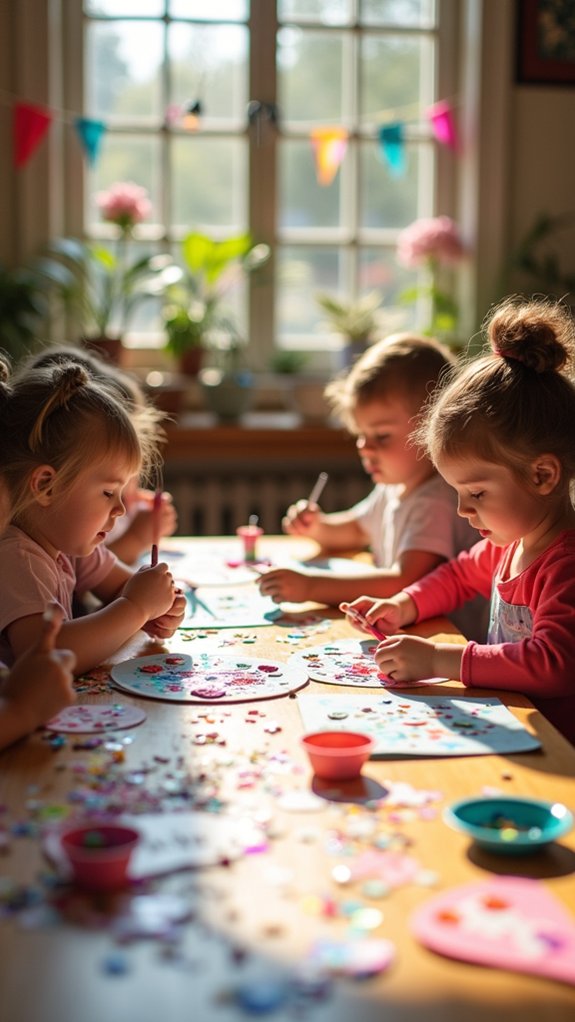
From decorating our homes for different seasons, children can also mark their personal territories through creative expression. Personalized room signs offer kids a chance to declare “This is MY space!” while showcasing their artistic talents. Using simple materials like chalkboards, watercolor paints, and ribbons, children create door decorations that reflect their personalities.
| Materials | Difficulty | Age Range | Time Needed |
|---|---|---|---|
| Chalkboards | Easy | 5-8 years | 30 minutes |
| Watercolors | Medium | 8-10 years | 45 minutes |
| Wood & Ribbon | Medium | 9-12 years | 1 hour |
| Mixed Media | Challenging | 10+ years | 2 hours |
These crafts build ownership and identity while strengthening family bonds. Kids love changing their sign messages, which nurtures creativity and keeps their rooms fresh. The best part? Each time they pass their door, they’re reminded of their amazing creative powers!
Upcycled Container Gardens: Growing Creativity
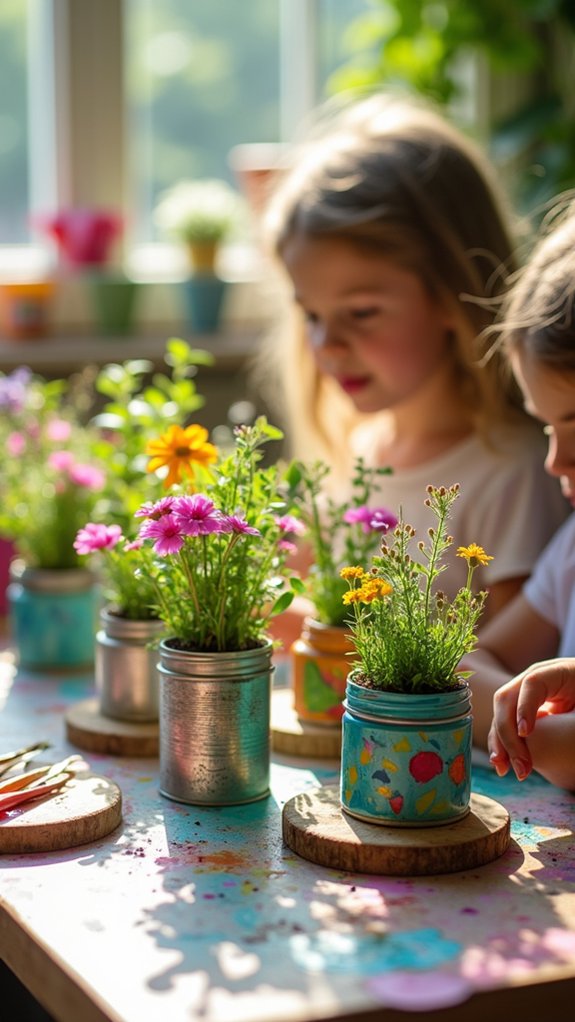
Countless discarded items that might otherwise end up in landfills can transform into vibrant, living gardens with a child’s creative touch. This easy and fun project helps kids connect with nature while learning valuable lessons about plant growth and responsibility.
The gardening experience reduces stress and boosts mood, making it a perfect afternoon activity.
Container gardens work brilliantly in small spaces, from apartment balconies to classroom windowsills. Children can personalize their mini-gardens with wild creativity!
- Collect and clean used materials like plastic bottles, tin cans, or old boots
- Decorate containers with paints, markers, or collage materials to reflect personality
- Add soil, seeds, and regular water—then watch the magic of growth unfold!
Homemade Musical Instruments: Crafting With Sound
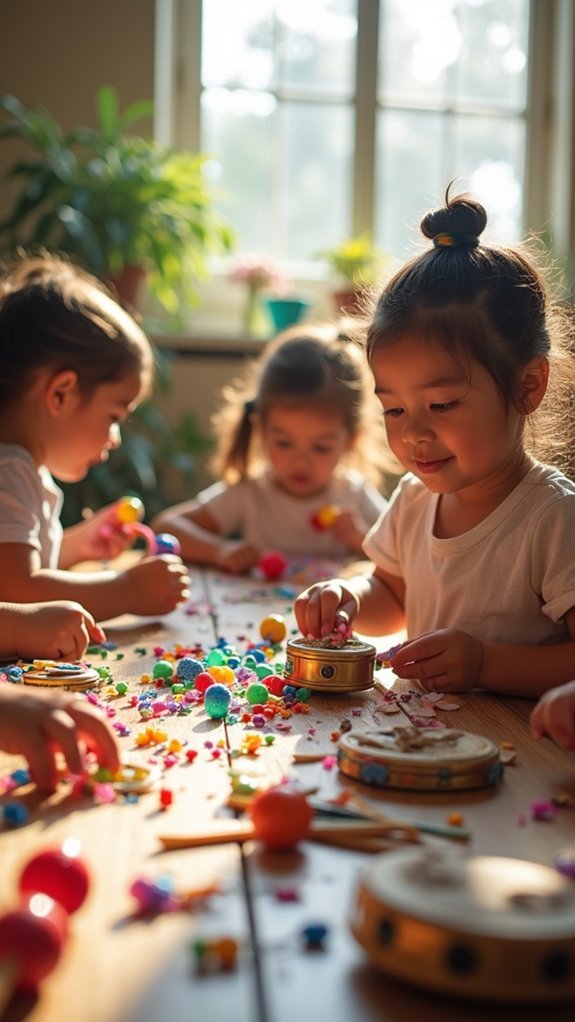
While plants grow silently in their creative containers, music brings a whole new dimension of expression to craft time. Kids can transform household items into fantastic musical instruments, turning trash into tuneful treasures! With some crafting paper, empty bottles, and rubber bands, young musicians can explore rhythm while boosting their brain power.
| Instrument | Materials Needed | Skill Level |
|---|---|---|
| Water Xylophone | Glass bottles, water, stick | Easy |
| Cardboard Guitar | Box, rubber bands, tape | Medium |
| Paper Plate Tambourine | Plates, bells, stapler | Easy |
These DIY instruments aren’t just fun to make—they’re awesome for development too! When kids bang, strum, and shake their creations, they’re actually improving memory and language skills. Plus, jamming together creates social bonds that last way longer than the instruments themselves. How cool is that?
Frequently Asked Questions
How Do I Manage Craft Supplies on a Limited Budget?
Organizations manage craft supplies economically by prioritizing multipurpose materials, seeking donations, utilizing thrift stores, and exploring dollar stores. Budget friendly solutions include recycling household items and hosting supply swaps.
What Crafts Work Best for Children With Sensory Processing Difficulties?
For children with sensory processing difficulties, crafts using sensory friendly materials like moldable clay, textured papers, and soft fabrics provide manageable tactile experiences without overwhelming stimulation. Visual schedules enhance predictability during activities.
How Can Crafts Support STEM Learning Concepts?
Crafts support STEM learning through hands-on experimentation, fostering problem-solving and critical thinking skills. STEM integration occurs when projects incorporate measurement, scientific principles, engineering challenges, and mathematical concepts simultaneously.
Which Projects Are Safest for Toddlers Under Three?
Projects safest for toddlers under three include finger painting with edible paints, playdough sculpting, pom-pom sorting, large bead stringing, and paper crumpling. Toddler safety requires adult supervision and non-toxic materials.
How Do I Remove Craft Stains From Clothes and Furniture?
Stain Solutions vary by material. For fabrics, pre-treat with vinegar or dish soap before washing. On furniture, blot immediately with appropriate cleaners, avoiding excessive moisture on upholstery.
Conclusion
Crafting opens up worlds of possibility for kids, turning everyday moments into adventures of creation. These fifteen projects aren’t just about making things—they’re about building confidence, problem-solving skills, and memories that last. So gather those recyclables, fold that paper, and watch as glue and imagination transform the ordinary into something magical. In a world of screens, crafting reconnects kids with their hands, hearts, and boundless creativity.

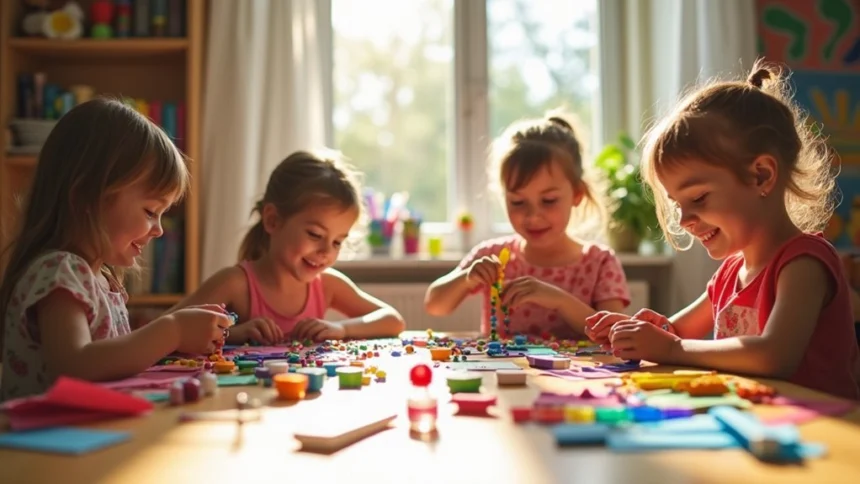
Leave a Reply